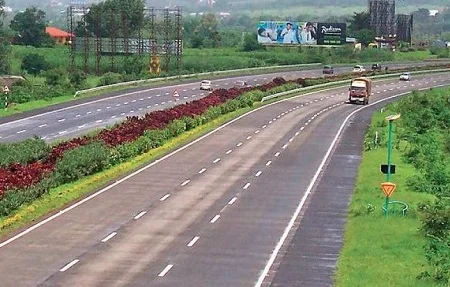
By the year 1981, this plan anticipated an overall road length of 10,57,330 km (achieved). Based on the price level in 1958, the cost of the plan has been calculated at Rs. 5,200 crores. The lengths of the NH, SH, MDR, ODR, and VR were calculated using five different formulas.
NH (km) = [A/64+ B/80 +C/96] + [32K + 8M] +D
NH+ SH, (km) = [ A/20 + B/24 + C/32] + [ 48K + 24 M + 11.2 N + 1.6 P] + D
NH + SH+ MDR ( km) = [ A/8 + B/16 + C/24] + [ 48 K + 24 M + 11.2 N + 9.6 P + 6.4 Q+ 2.4 R] + D
NH+SH+MDR+ODR, (km) = [3A/16+3B/32+C/16] + [48K +24 M + 11.2 N +9.6P + 12.8 Q + 4R + 0.8 S + 0.32 T] + D
NH+SH+ MDR+ ODR+ VR (km) = [ A/4 + B/8 + C/12] + 48K + 24 M + 11.2 N + 9.6 P + 12.8 Q + 5.9 R + 1.6 S + 0.64 T + 0.2 V] +D
Where,
A = Developed and agricultural areas, sqkm
B= Semi-developed area, sqkm
C = Underdeveloped area, sqkm
K = number of towns with population over 1,00,000
M = number of towns with population range 1,00,000 – 50,000
N = number of towns with population range 50,000- 20,000
P = number of towns with population range 20,000- 10,000
Q = number of towns with population range 10,000- 5,000
R = number of towns with population range 5,000- 2,000
S = number of towns with population range 2,000- 1,000
T = number of towns with population range 1,000- 500
V = number of towns with population range below 500
D = Development allowance of 5 percent of road length calculated for further development and other unforeseen factors.
Bombay road plan (1961- 81) or second 20-year road plan
- Duration = 1961 -81
- Road density = 32 km/100 km²
- Development allowance = 5%
- Length of express ways = 1600 km
Salient Features of Second Twenty Year Road Plan:
- Based on increased scientific research due to the necessity for development in underdeveloped areas. Targeted road density was 32 km per 100 sq m; the actual road length was 15,02,697 km.
- The maximum distance from any location in a developed or agricultural region to a metalled road is 6.4 km, and the maximum distance from any other category of roads is 2.4 km.
- A metalled road should connect every town with a population of at least 2000 in plains, 1000 in semi-hilly areas, and 500 in hilly areas.
- When estimating the length of a road in mountainous areas, a 100 percent allowance should be taken into account.
- In this proposal, expressways have also been taken into account, and a goal length of 1600 km for national highways has been suggested.
- The length of a railway track is thought to be independent of the network of roads.
- For unforeseen circumstances and future development, a development factor of just 5% is offered.
